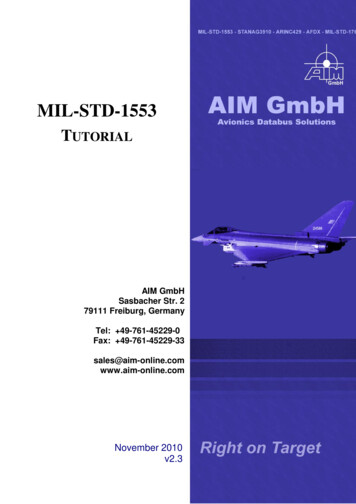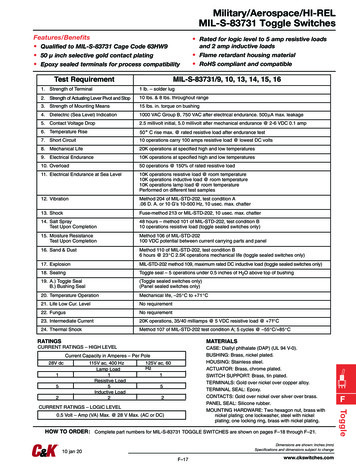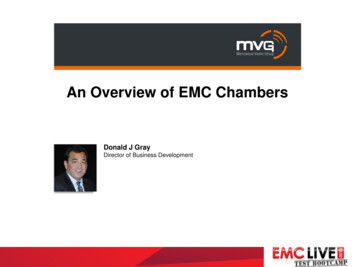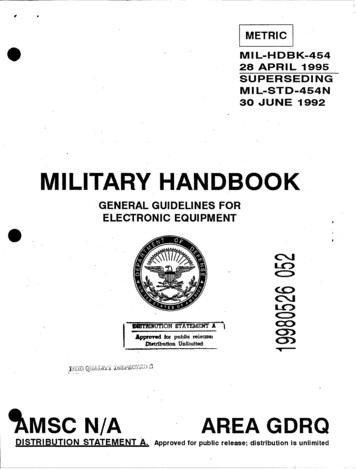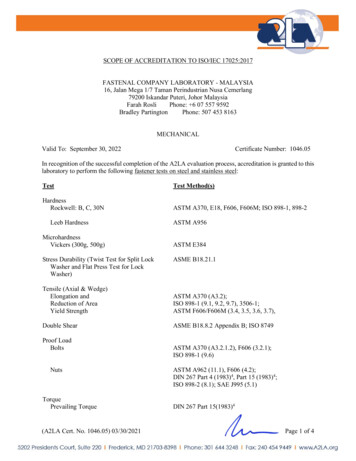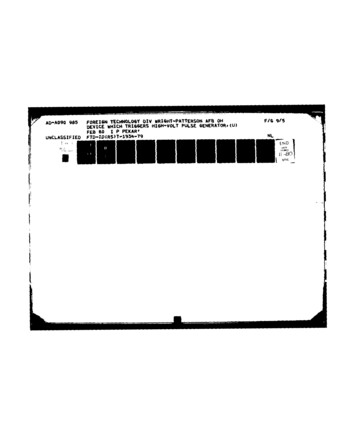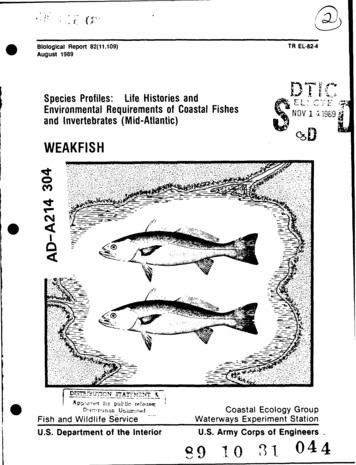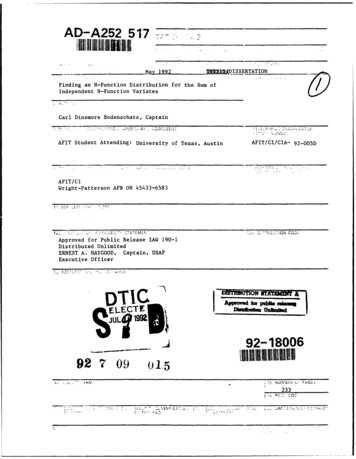
Transcription
AD-A252 517CWIS SERTATIONMay 1992Finding an H-Function Distribution for the Sum ofIndependent H-Function VariatesCarl Dinsmore Bodenschatz, Captain- -C-DSIT LA!AFIT Student Attending: University of Texas, AustinAFIT/CI/CIA- 92-005DAFIT/CIWright-Patterson AFB OH 45433-6583-.E.-'TA%ILNApproved for Public Release lAW 190-1Distributed UnlimitedERNEST A. HAYGOOD, Captain, USAFExecutive OfficerIDTICuMrm .ELECTEJUL f 192 .19-18006 92 7 09015233 .-.F. .,, .
FINDING AN H-FUNCTICtDISTRIBUTIONFOR THE SU4 OF INDEPENDENTH-FUNCTICN VARIATESbyCARL DINSKORE BODDISCATZ,B.A., H.S.DISSETATIONPresented to the Faculty of the Graduate School ofThe University of Texas at Austinin Partial Fulfillnmntof the Requirementsfor the Degree ofDOCTOR OF PHILOSOPHYTHE UNIVERSITY OF TEXAS AT AUSTINMay 1992
To God,for the beauty and sirrplicity of the H-functionand for my ability to study it;To my parents, Carl A. and Jody,for teaching me the value of knowledgeand instilling in me a cnmitment to quality ineverything I atteapt;To my wife, Debbie,for her continued love and friendship,honesty, pureness of heart, and inner strength;To my sons, Luke, John, and Paul,for their future challenges, comitmnnt toexcellence, and coplete fulfillment.AcoessionForNTISRA&IDTIC TABUuannouncedJust ification:/00DlstBy ribut !on/Availability CodesDietAvail anid/orspecial
FINDING AN H-FUNCION DISTRIBUTICFOR THE SX4 OF INDEPENDENTH-FUNCTION VARIATESAPPROVED BYDISSERTATION CO*ITTEE:esesleyS Paul A. JenW. T. Guy, Jr.0*-Q.,fb4- 401 iVeD.ID.4-ok,,Jr. .dt''
CopyrightbyCarl Dinanore Bodenschatz1992
A(,cNaLEDGEN4TSI would like to express my sincere admiration, gratitude,and respect to Dr. J. Wesley Barnes, my supervising professor,who embodies the perfect combination of theoretical insight,practicality, intelligence, and cornvn sense.His suggestionswere always correct, timely, and properly measured.My gratitude extends to Drs. Paul A. Jensen, William T.Guy, Jr., Olivier Goldscbhidt, and Ivy D. Cook, Jr. for theircontributions as members of my dissertation canittee and asinstructors in my graduate courses.A special note of thanksis due Dr. Cook for introducing me to the fascinating world ofH-functions and encouraging my continued research in this area.I also want to thank the other faculty menbers, staff, andgraduate students in the Department of Mechanical Engineeringfor their instruction, support, and friendship.I agrateful to the Department of Mathenatical Sciencesat the U.S.program.and ourAir Force Academy for sponsoring my doctoralMost importantly,sons for theirI want to thank my wife, Debbie,love,understanding,patience,support throughout this experience.C. D. B.vand
FINDING AN H-FUNCTION DISTRIBUTIONFOR THE SUM OF INDEPNIDE TH-FUNCTION VARIATESPublication No.Carl Dinmnore Bodenschatz, Ph.D.The University of Texas at Austin, 1992Supervisor: J. Wesley BarnesA practical method of finding an H-function distributionfor the sum of two or more independent H-function variates ispresented.Sirrple formulas exist which imediately give theprobability density function, as an H-fumcticn distribution, ofthe random variable defined as the product, quotient, or powerof independent H-function variates.Unfortunately, there areno similar formulas for the sum or difference of independent Hfunction distribution whose moments closely Tatch the moments of thevi
randaovariable defined as the sum of independent H-functionvariates.This allows an analyst to find the distribution ofmore complicated algebraic combinaticns of independent randamvariables.The method and inplementing computer program aredemonstrated through five exarnples.For comparison, the exactdistribution of the general smu of independent Erlang variateswith forms and partial fractions decomposition.The H-functionisthe mostgeneralspecialfunction,enccipassing as a special case nearly every named matheaticalfunction and continuous statistical distribution.The Laplaceand Fourier transforms (and their inverses) and the derivativesofan H-functionare readily-determinedH-functions.Mellin transform of an H-function is also easily obtained.TheTheH-function exactly represents the probability density functionand cmarulative distribution function of nearly all continuousstatistical distributions defined over positive values.A previously unstated restriction on the variable in theH-function representationsfunctions ishighlighted.of power functions and beta-typeSeveralways of overcomning thislimitationwhenpresented.The restriction, however,representingviinathaiticalisfunctionsarean advantage when
representing certain statistical distributions.Many new H-function representations of other mathematicalfunctions arealso given.The hierarchical structure among classes of H-functions isgiven through seven new theorens.Every class of H-functionsis wholly contained in mny higher-order classes of H-functionsthrough the application of the duplication, triplication, andnultiplication formulas for the gamma function.Four newtheoremsshowwhenandhowageneralizingconstant my be present in an H-function presentationscumulative distributionare given,function variate.viiifunctionManyincludingofan H-
TABLE OF COTETSPAGECIMPTER1. INTRODUCTION AND REVIEW .11.1.Purpose and Scope .11.2.Literature Survey .41.3.Integral Transforms and Transform Pairs .81.3.1.Laplace Transform .91.3.2.Fourier Transform .111.4.1.3.3. Mellin Transform .12Transformations of Independent Random Variables .131.4.1.Distribution of a Sum .151.4.1.1.Infinite Divisibility .171.4.1.2.Special Cases .171.4.1.3. Reproductive Distributions .181.4.2.Distribution of a Difference .191.4.3.Distribution of a Product .201.4.4.Distribution of a Quotient .211.4.5.Distribution of a Variate to a Power .221.4.6. Moments of a Distribution .ix22
PACEC21AP'ER2. THE H-FUNC1'ION .*242.1.Primrary Definition. 252.-Alternate Definition.272.3.Sufficient Convergence Conditions .282.4.Properties . 362.4.1.Reciprocal of an Argumrent . 372.4.2.Argument to a Power . 372.4.3. Multiplication by the Argument to a Power382.4.4.First Reduction Property . 382.4.5.Second Reduction Property . 39*2.4.6.Hierarchical Relationships AmongOrders of H-Fumctions . 40*2.4.7.Generalizing Constant . 492.4.8.Derivative. 592.4.9.Laplace Transform. 612.4.10.Fourier Transform . 622.4.11. Mellin Transform. 63Mathematical Functions . 63*2.5.Special Cases*2.6.Functions Represented Over a Restricted Range .76Mofnents of an H-Function and Infinite Summubility80*2.7.2.8.-Evaluation of the H-F'.mction . 84x
PACECHIAPTER3.THE H-FUNCTION DISTRIBUTION .873.1.Definition .873.2.Moments of an H-Function Distribution .883.3.Evaluation of the H-FunctionDistribution Constant .89*3.4.Cumulative Distribution Function .91*3.5.Special Cases - Statistical Distributions .93*3.6. Arbitrary Ranges for Type VI H-Function Variates3.7.109Transformrations of IndependentH-Function Variates . 1123.7.1.Distribution of a Product .1133.7.2.Distribution of a Quotient .1153.7.3.Distribution of a Variate to a Power .1173.7.4. Use of Jacobs' (B,b) Plot in FindingPowers of First Order H-Function Variates 118*3.7.5.Distribution of a Sum . 1224. FINDING AN H-FUNCTION DISTRIBUTION FOR THE L14 . 1264.1. Moments of the Sum . 1294.2.H-Function Parameter Estinates .1314.2.1.Method of Mcments . 1324.2.2.Reducing the System ofNonlinear Equations . 133xi
PAGEC2MPTER4.2.3.Solving the System ofNonlinear Equations . 136*4.3.Special Considerations for Type VIH-Functicm Variates . 138*4.4. Demonstration of the Technique . 1414.4.1.Example 1 - Sum of Three Independent,Identically Distributed Gamma Variates . 1454.4.2.Example 2 - Sum of Two Independent4.4.3.4.4.4.Erlang Variates with Different X .147Example 3 - Sum of Two IndependentStandard Uniform Variates .148Exaiple 4 - Sum of Two Independent,Identically Distributed Beta Variates4.4.5. 150Example 5 - Sum of Two IndependentVariates with Weibull and RayleighDistributions . 1525. COMPARING THE ESTIMATED H-FUNCTION TO THE EXACTDISTRIBUTION OF THE SUM .5.1.Finding the Exact Distribution of the Sun .5.1.1.154155Convolution Integral . 1565.1.2. Reproductive Distributions . 1635.1.3.5.2.Erlang Distributions with Different X .164Measures of Merit . 1725.2.1.Estimated Sums of Squares of Error .1735.2.2. Estimated Mean Squared Error . 174xii
PAGECHAPTER5.2.3. Maximum Absolute Difference . 1745.2.4.*5.3.Integrated Absolute Density Difference . 174Demmstrated Results . 1755.3.1.Example 1 - Su of Three Independent,. 175Identically Distributed Gamma Variates5.3.2.5.3.3.5.3.4.Example 2 - Sun of Two IndependentErlang Variates with Different X .176Example 3 - Sum of Two IndependentStandard Uniform Variates .178Example 4 - Sun of Two Independent,.181QI4CLUSIONS AND RECMEinDATINS FUR FURTHER S UDY .184Identically Distributed Beta Variates6.APPENDIXA.OUTPUT FROM Conn PROGRAM.193B. GRAPHICAL DEPICTIONS OF SUMS OF SELECTED INDEPEDENTUNIFORM, POWER FNCTION, AND BETA VARIATES .220BIBLIOGRAPHY .225VITA . 232*Indicates the section contains significant new material.xiii
LIST OF FI(JRESFigure1Venn Diagram of Certain Ccamn StatisticalDistributions as H- 0 and Hi00 11 1 H-FunctionDistributions . 1082Classical Statistical Distributions as FirstOrder H-Functions in (B,b) Space . 1193Graphical Comparison of the H-Function and theExact Distribution of Example 2 . 1784Graphical Ccrparison of the H-Function and theExact Distribution of Exanple 3 .180Graphical Camparison of the H-Function and theExact Distribution of ExaMple 4 .1835xiv
LIST OF TABLESTablePage1Convergence Types for H-Functions of Eq (2.1) .302Convergence Types f or H-Functions of Eq (2.2).333Maoents of Trigonetric and Hyperbolic Functions .84xv
CHAPTER 1INTROW ICt AND REVIE1.1.PURPOSE AND SCOPEThe primary purpose of this research effort was to developa practical method of finding an H-function distribution forthe sum of two or more independent H-function variates.Simpleformulas exist which immediately give the probability densityfunction (p.d.f.), as an H-function distribution, of the randomvariabledefinedastheproduct,independent H-function variates.quotient,orUnfortunately,powerofthere are nosimilar formulas for the sum or difference of independent Hfunction variates.A related issue was whether the class of H-functions isclosed under the operation of multiplication.In other words,is the product of two H-functions another H-function?It isimportant to nake the distinction here between the product oftwo H-functions and the p.d.f. of the random variable definedas the product of two H-function variates.that the latter case is an H-function.unproven.Itis well knowBut the former case wasOf course, similar statements can be made about the1
2quotient of two isclosedone could easily find the p.d.f.under(as an H-function) of the sum or difference of independent H-functionvariates.The Laplace(or Fourier)transforms ofthe H-function variates in the sum (or difference) are immediatelyavailable as H-functions of higher order.The product of theseH-functions (in transform space) would yield the transform ofthe desired density.H-function,itIf this product was available as ly.Because the H-function can exactly represent nearly everycommon mathematical function and statistical density, there wasample reason to suspect that the product of two H-functionswas,in general,another H-function.Indeed,there are manycases where two individual functions and their product are allspecial cases of the H-function.Throughout this thesis, a number of other new results areidentified with an asterisk.Sufficient convergence conditionsfor the alternate definition of the H-function are given inSection 2.3.These show how the H-function nay be evaluated bythe sum of residues,without first changing the form of thealternate definition of the H-function to that of the primary
3definition.The hierarchical structure among classes of H-functions isgiven through seven new theorems in Section 2.4.6.Every classof H-functions is wholly contained in mnny higher-order classesthrough the application of the duplication,of Figure 1informulasSection 3.5forthegammillustratesthishierarchical structure with a venn diagramn showing mony commiostatistical distributions as first and second order H-functiondistributions.Four new theoremgeneralizingconstantrepresentation.are given,in Section 2.4.7 show when and how anaybepresentanH-functionMany generalized H-function representationsincluding those of every cumulative distributionfunction of an H-function variate.isinThe generalizing constantalso possible in the H-function representations of powerfunctions,theerrorfunctionanditsincomplete gamma function and its ccmplemunt,beta function and its complement,conplement,thethe incmpletemny inverse trigonometricand hyperbolic functions, and the logarithmic functions.A number of new H-functionrepresentations ofcertainmathematical functions and statistical distributions are givenin Sections 2.5, 2.6, and 3.6.Several of these expand upon a
4previously unstatedfunctionlimitationrepresentationsofon the variablepowerfunctionsinthe H-and beta-typefunctions.The exact distribution of the general sum of independentErlang variates with different scale parameters, X, is derivedin Section 5.1.3.An Erlang variate is simply a gamma variatewith an integer shape parameter r.The derivation uses partialfractions to decaqpose the product of Laplace transforms of theindividual densities.This produces a sum of terms, each ofwhich can easily be inverted fran transform space, yielding thedesired density of the sum of independent variates.Since the H-function is not defined for zero or negativereal arguments,to continuousvalues.the scope of this research effort was limitedrandom variablesdefined only over positiveContinuous and doubly infinite distributions such asthe normal and Student's t are only represented as H-functionsin their folded forms.1.2.LITERATURE SURVEYRegrettably,littleresearch inhas been done in the United States.the field of H-functionsMuch of what is knownabout the H-function is due to Indian mthemticians.Mathaiand Saxena [1978] and Srivastava et al [1982] compiled manyresults of the early study of H-functions.In recent years,
5Soviet mathematicians[Prudnikov et al,considerable interestin1990] have shown athe H-function and have developedsignificant new results.The foundation of H-function theory is grounded in theintegral transform theory, complex analysis,gasmfunction,andstatisticallandmarkErd lyidistributionsuch as Abramowitzreferences[1953],theory.Erd lyi [1954],Therefore,severaland Stegun[1970),and Springer [1979],thoughsomewhat dated, have timeless value.Carter[1972]defined the H-function distribution and,using Mellin transform theory,results showing that products,gave startling and powerfulquotients, and rational powersof independent H-function variates are themselves H-functionvariates.Further, the p.d.f. of the new random variable caninuediately be written as an H-function distribution.Theusual techniques of conditioning on one of the random variablesand/or using the Jacobian of the transformation are no fulwhenonerealizes that nearly every common positive continuous randomvariableTherefore,products,canbewrittenthe p.d.f.quotients,asanH-functiondistribution.of any algebraic combination involvingor powers of any number of independent
6positive continuous random variables can imiediately be writtenas an H-function distribution.Carter [1972] also wrote a FCRTRAN computer program pendent H-function variates and approximate the p.d.f. andcumulative distribution function (c.d.f.) from these nunents.The approximation procedure was developed by Hill [1969] and,if possible, uses either a Grar-Charlier type A series (Hermitepolynomial)or a Laguerre polynomialseries.Ifa seriesapproxirration is not possible, the first four nmrents are usedto fit a probability distribution from the Pearson family.Carter [1972] himelf notes ".Asthere were nany situations inwhich the nethods did not work or in which the approxirationswere totally unsatisfactory."Springer [1979] literally wrote the book on the algebra ofrandom variables.He gives an excellent explanation of thevalue of integral transformin finding the distribution ofalgebraic combinations of random variables.He also gave theknown applications of the H-function in these problem.Cook [1981] gave a very thorough survey and an extensivebibliography of the literature related to H-functions and Hfunction distributions.He also presented a technique forfinding, in tabular form, the p.d.f. and c.d.f. of an algebraic
findependent H-function variates.Cook's technique [1981; Cook and Barnes, 1981] first usesCarter's [1972] results to find the H-function distribution ofany products, quotients, or powers of random chH-functionfunctionscorresponding evaluatedandThesumThesemultipliedof the transform variable,ofatyielding atabular representation of the Laplace transform in transformspace.This Laplace transform isusing Crurp's method.then numerically invertedHis FORTRAN computer program implementsthis technique and will plot the resulting p.d.f. and c.d.f.Bodenschatz and Boedigheimer [1983; Boedigheimer et al,1984] developed a technique to fit the H-function to a set ofdata using the method of moments. The technique can be used tocurve-fit a mathematical function or to estimate the density ofa particular probability distribution.program will accept known moments,pair data from a relativeTheir FORTRAN coMputerunivariate data,frequency,orderedor ordered pair datadirectly from the function.Kellogg[1984;Kelloggand Barnes,1987;KelloggandBarnes, 1989] studied the distribution of products, quotients,
8and powers of dependent random variables with bivariate Hfumction distributions.Jacobs [1986;Jacobs et al,1987]presented a method of obtaining parameter estimates for the Hfunction distribution using the method of maximum likelihood orthe method of moments.Prudnikov et al [1990] gave extensive tables of H-functionresults and Mellin transform.Their books,although moreterse than the series by Erd6lyi [1953 and 1954], are at leastas complete and, likely, will become the new standard referencefor special functions.1.3.INTERAL TRANSFCRS AND TRANSFORM PAIRSIntegral transforms are frequently encountered in severalareas of mathematics,probability,and statistics.Althoughvarious integral transforms exist, certain characteristics arecamxmiamong them.The function to be transformed is usuallymultiplied by another function (called the kernel)integrated over an appropriate range.various transformintegration,are the kerneland thenWhat distinguishes thefunction,and the type of integrationthe limits of(e.g.Riemaunn orLebesgue).Oftendifficultthe use n simplify ausuallyfirstencountered in the solution of systems of linear differential
9equations.In probability and statistics, certain integraltransforms are often known by other names such as the mom-entgenerating function,characteristicfunction,or probabilitygenerating function.Thedefinitionsstandard.of mostintegraltransformsare notIt is important, therefore, to explicitly state theform of the definition to be used.Listed below are ute a transform pair.1.3.1.LAPLACE TRANSFORMConsider a function f(t) which is sectionally continuousand defined for all positive values of the variable t withf(t) O for tO.A sectionally continuous function may not havean infinite number of discontinuities nor any positive verticalasymptotes.Iff(t) grows no faster than an exponentialfunction, then the Laplace transform of f(t) will exist.Theremust exist two positive nunbers M and T such that for all t Tand for same real number a,f (t )t(1.1).
10The definition of the Laplace transform of the functionf(t), zsf f(t)}, isZ (tJoe-}(1.2)f (t) dt0In general,s is a complex variable.f(t) willexist(Re(s)fortherealpartThe Laplace transform ofofsgreaterthan a a).The inversion integralor inverse Laplacetransform isgiven byJf(t)where-fest ZsftM)} isf(t)ds(1.3)an analytic function for Re(s) w.function is analytic at s s0 if its derivative exists at sat every point in some neighborhood of s o .AandThe Taylor seriesexpansion of an analytic function of a ccrplex variable willexist,converge,argument.andequalthe functionevaluatedat theFor all practical purposes, a function f(t) and itsLaplace transform (if it exists) uniquely determine each other.In probability and statistics, if f(t) is the p.d.f. of arandom variable defined only for positive values, its momentgenerating function issinply the Laplace transform with r
11replacing -s in Eq (1.2).1.3.2.FOURIER TRANSFMThe form of the exponential Fourier transform used in thisthesis is,s{f(t)}e stf(t)dt(1.4)The Fourier transform is a function of the coniplex variable s.If f(t) is a p.d.f.,this definition corresponds to thedefinition of the characteristic function in probability andstatistics.The characteristic function of a p.d.f. willalways exist but the nmnnt generating function of a p.d.f. nayor ay not exist.The inversion integralor inverse Fourier transform isgiven bywheref ()*1imf(t)tt 0 f(t) 1imtlt 0t t(1.6)t t oIf f(t) exists and is continuous at tthe inverse Fourier
12transform ofY,(f(t) )willgive f(t).Iff(t) iscontinuous at to, the inverse Fourier transform of Ynotf(t)}will produce the average of the limits of f(t) from the left ofto and the right of to.1.3.3.MELLIN TRANPOINBecause the Mellin transform is perhaps less well knownthan the Laplace or Fourier transform and because the Mellintransform isso crucialinthe study of H-functions,com n sets of transform pairs will be presented.transform uses a powerbothThe Mellinfunction instead of an exponentialfunction as its ycontinuous and defined for all positive values of the variablet with f(t) O for t,o.Using what will be regarded in thisthesis as the primary definition of the Mellin transform, theMellin transform of f(t), AA(f(t) ) f(t)},isJotS 1 f(t) dt(1.7)0The Mellin transform is related to the Fourier and Laplacetransforms as follows [Erd6lyi, 1954, p.305]:
13f f(t)} f(et)f-i{{-Again,sisf(et)(1.8)} }f(e-)Z{a carplex variable.(1.9)The Mellin transforminversion integral, or inverse Mellin transform, is given as1,(O iCOc1-iAs mentioned earlier, there is another important transformpairalsoreferredalternateto asdefinitiondefinitionofthewilla MellinariseH-functiontransform efinition isi f(t)} Jt-rl f(t) dt(1.11)0with inverse transformf(t)JVVC xr{J f(t)}dr(1.12)u-iCD1.4.TRANSFUA canmnfindtheTICIS OF INDEHWIT RANDC4 VARIABLESproblem in statistical distribution theory is todistributionofanalgebraiccombinationof
14The algebraic cumbination couldindependent random tsand/orindependent random variables or their powers.Itisofimportantto recognize that the algebraic combination is itself a randomThevariable and, therefore, has a probability distribution.task is to find this distribution.itUsing the properties of mathematical expectation,isrelatively easy to find the mean, variance, and other nxmentsof the algebraic cumbination of independent random variables.the mean of the sum of two independent randomFor example,variablesissimplythe meansthe sum ofofthe randomFinding the completely specified distribution ofvariables.the algebraic combination is usually much more difficult.For simple ccubinaticns of independent randum variables,the method of Jacobiansone-to-onetransformationis often employed.betweentheAn appropriateindependentrandumvariables in the algebraic cumbination and a set of new setransformation functions, the Jacobian (the determinant of thematrix of first partial derivatives of the inverse functions)may be computed.The joint p.d.f. of the newly defined random variables isthe absolute value of the Jacobian multiplied by the product of
15theoriginaldensitieswiththeinversefunctions substituted for the variables.transformationA great deal of caremust be used in determining the values of the new variables forwhich the joint density is nonzero.Cnce this is done, thedesired marginal density can be obtained by integrating overthe complete ranges of the other new variables.An example of the method of Jacobians will be presentedbelow.In most of the following sections, however,only theresult using integral transforms will be given.1.4.1.LetX1DISTRIBUTION OF a SMand Xbeindependentrespective densities f i(x)2.variableswithand f 2 (x), each nonzero only forpositive values of the variable.of Y X XrandnSuppose we want the densityUsing the method of Jacobians, we define W X 2 sothe inverse transformations are XI Y-W and X--W.The Jacobianis: n:10(1.13)1The joint density of Y and W isfywCY,w) f1 (y-w) f 2 (w)The marginal p.d.f.0 W y C(1.14)of Y can be obtained by integrating thejoint p.d.f. with respect to W over the range of W.
16 J1 0Eq (1.15)integralfl(Y-w) f2 (w)dw(1.15)nay be recognized as the Fourier convolution(Springer,1979,p. 47].This isno accident orcoincidence as the Fourier or Laplace transform could also havebeen used to find the distribution of Y.It is well known thatthe Laplace (or Fourier) transform of the p.d.f. of the sum oftwo independent random variables defined for positive values isthe product of the Laplace (or Fourier)individual densities.Further,transforms of thethe product of two transformfunctions, upon inversion, yields a convolution integral.If the product of transform functions can be recognized asthe transform of some function, then the convolution inversionisnot necessary.transform isThe p.d.f.the product.of Y isthe function whoseWhen statisticians use the momentgenerating function of each density to find the p.d.f.of Y,this recognition approach isusually taken.using transform functions isthat the procedure easily extendsone advantage ofwhen the distribution of the sum of three or more independentrandom variables is desired.Finding the distribution of the sum of independent randomvariableswithcertainconsiderably sinplified.specialdistributionalformsisSeveral of these cases are covered in
17the following subsections.1.4.1.1.INFINITE DIVISIBILITYAlthough a ccmplete discussion of infinite divisibility isbeyond the scope of this thesis, its definition is given below[Petrov, 1975, p. 25).A distribution function F(x) and the correspondingcharacteristic function f(t) are said to beinfinitely divisible if for every positive integer nthere exists a characteristic function fn(t) suchthatf(t) (fn(t))nIn other words, the distribution F is infinitelydivisible if for every positive integer n thereexists a distribution function Fn such that F F*n .Here F*n is the n-fold convolution of the functionnF.nCcmnon exanples of infinitely divisible distributions includethe normal and Poisson distributions.1.4.1.2.TheSPECIAL les with certain distributional form is well known andimrediately available.For exanple, the sum of n independentand identically distributed randmn variables with a Bernoullidistribution with parameter p has a Binanial distribution withparametersn andgeometricallyp.Similarly,distributedrandomthe sum ofvariableswithindependentacaot
18parameter has a negative BinaTial (or Pascal) distribution.the sum of n independentIn continuous random mdistribution with parameters n and X.1.4.1.3.AREPRODUCTIVE svariablespositiveisaddition"reproductive"ofwith the same distributionalindependentifitrandomThe normalform.distribution is reproduct
Mellin transform of an H-function is also easily obtained. The H-function exactly represents the probability density function and cmarulative distribution function of nearly all continuous . Table Page 1 Convergence Types for H-Functions of Eq (2.1) . 30 2 Convergence Types f or H-Funct
